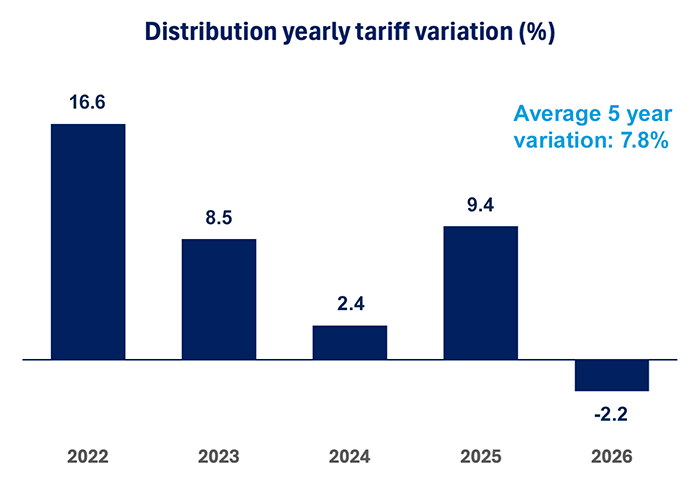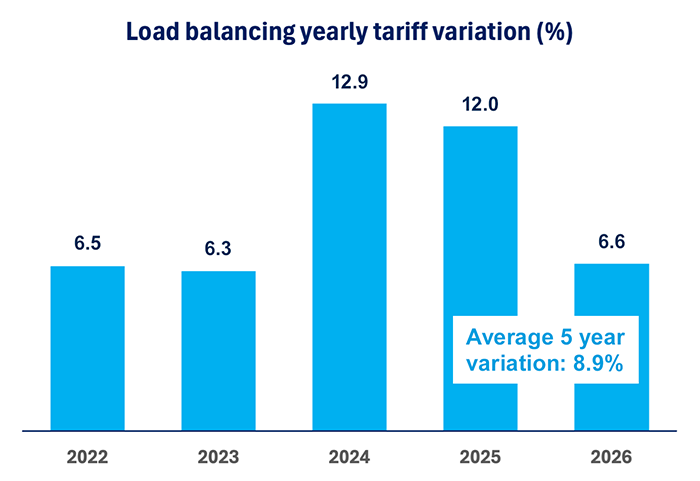New rates for fall 2025
Énergir’s proposed new rates were filed with the Régie de l’énergie on May 8 and are currently awaiting approval, with an intended application on October 1, 2025. Learn more about our price changes in each section.
1. Price of Énergir's services
Overall, for all of Énergir’s services, the 2025-2026 rate case results in a rate increase of 1.15%, broken down as follows:
- 2.15% decrease in distribution rates
- 18.10% decrease in transportation rates
- 6.61% increase in load-balancing rates
- 1.90% decrease in CATS inventory adjustments
- Increase in the RNG socialization fee following the increase in the RNG injection target in the distribution system
Énergir’s distribution rates for 2025–2026 are down 2.15%.
The main contributors to the decrease are as follows:
- Changes in net deferred expense account (DEA) balances relating to prior-year amounts to be returned to customers in connection with overpayments, revenue decoupling and budget variances related to future employee benefits.
Partially offset by:
- The change in the net DEA balance relating to temperature and wind rate stabilization. A warmer than average winter in 2024- 2025 resulting in lower than expected revenue.
What is a deferred expense account (DEA)?
A DEA is a regulatory tool used to calculate incurred fees that will be deferred to a later date.
Depending on the situation, deferred fees may be remitted or recovered from customers. If there are fees to be recovered, there will be a rate increase. If there are fees to be remitted, there will be a rate decrease. There are a number of reasons for using DEAs. The most common is the determination of actual results at the end of the year that prove to be higher or lower than anticipated in the rate case. The resulting difference is then incorporated into a subsequent year’s rates.
The rate decrease of 18.10% for transportation is largely attributable to:
- Lower transportation costs, due mainly to the change in the location differential on natural gas purchases from Empress versus Dawn
- The decrease in depreciation from the overpayment in fiscal year 2023–2024 and the end of the shortfall recovery for fiscal year 2020–2021
Partially offset by:
- The decrease in transportation revenue due to lower distributed volumes
The 6.61% increase in the load-balancing rate is mainly due to:
- The increase in load-balancing costs, mainly due to the decrease in exchange transactions leading to optimization revenues and higher storage costs, offset by the change in the location differential on natural gas purchases from Empress.
- The increase in depreciation due to the higher shortfall in fiscal year 2023–2024 than in fiscal year 2020–2021
After four years of distribution rate increases, a reduction is proposed for 2025–2026. Additionally, transportation costs continue to be adjusted downward, helping to offset an increase in load-balancing costs.



As indicated in its 2024 Annual Report, Énergir met the target of 2% RNG in its distribution system as required by the Regulation respecting the quantity of RNG to be delivered by a distributor. Concretely, this represented 124 Mm3 of RNG, broken down as follows:
- 34 Mm3 of voluntary purchases by customers
- 90 Mm3 of volumes with socialized costs
Since a portion of this RNG was not purchased voluntarily by customers, the cost of unsold volumes is distributed through socialization fees. Customers who do not purchase the minimum percentage of RNG—i.e., 5% from October 2025 to September 2026—will see these fees adjusted on their bill.
What is the rate for the RNG socialization fee?
The rate for RNG socialization fee is 0.960¢/m3 for the 2025–2026 rate case. The socialization fee should represent 2.1% of an average customer’s total invoice.
Customers exempt from the RNG socialization fee rate
Customers whose RNG purchases equal or exceed the minimum threshold set by the government regulation are not subject to the RNG socialization fee rate.
Rate adjustments affect Énergir customers’ annual bills differently, depending on their natural gas consumption and their assigned rate tier.
The table below illustrates the effect of the rate variation on the annual bill of different customer profiles, shown both as a percentage and in dollars. These examples are intended to help customers better understand the potential financial implications of rate changes and to support informed energy planning.

* The variation in the annual bill takes into account transportation (T), load balancing (L-B), distribution (D) and RNG socialization fees (RNG soc.) but excludes the CATS and the natural gas supply – the price of the molecule varies monthly according to supply and demand.
2. Price of renewable natural gas (RNG)
In its 2025-2026 rate case, Énergir filed a rate proposal for RNG and is currently awaiting approval to implement the new rate on October 1, 2025. The price of RNG would then be increased from $22.65/GJ (85.818¢/m³) to $25.04/GJ (94.884 ¢/m³).
The price of RNG essentially represents the average acquisition cost of projected purchases throughout next year. The increase in the average purchase price is due to increasing RNG prices and the fact that Énergir must buy more RNG to meet regulatory targets. Initiatives are underway to stabilize and/or reduce the price of RNG.

